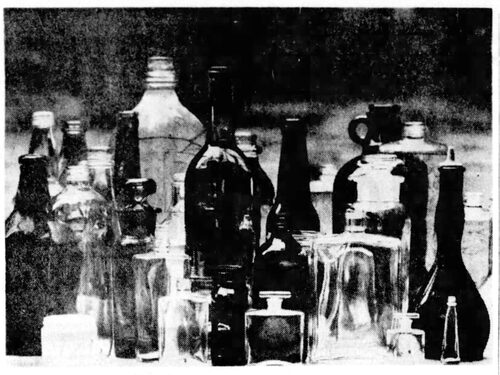[Newspaper]
Publication: The Cincinnati Enquirer
Cincinnati, OH, United States
vol. 119, no. 129, p. 40 Sect. I, col. 3-5
|
Glass container production hits 20 billion
. . . of all shapes and sizes
First Plant in Cincinnati
Ohio has Major Role
In Bottle, Jar output
Ohio manufacturrs [sic] manufacturers are responsible for a sizable portion of the 20 billion new glass containers produced in the United States every year.
The Ohio glass container industry began in Cincinnati in 1814 when Major Issac Craig established the Cincinnati Glass Manufacturing Co. at the foot of Smith Street.
Since that time glass container manufacturing has moved from Cincinnati to other parts of the state. And as it moved it grew.
Today two of the nation's, largest manufacturers of jars and bottles are located in the state. These are Anchor Hocking Glass Corp., Lancaster, and Owens-Illinois, Toledo.
And Hazel-Atlas Glass Division of Continental Can Co. Inc., Zanesville, and the Lamb Glass Co., Mount Vernon, have joined these two giants in the production of glass bottles and jars.
Together, these four Ohio companies helped to put the glass container business into the billion dollar category last year.
The 20 billion figure represents 116 new glass containers per capita.
Last year, some 41 billion jars and bottles — an average of 410 for every man, woman and child in the nation — "went to market" in the United States. This includes "reusables" and is considerably more than any other type of rigid container.
|
Jars for food
. . . largest market
TODAY OHIO'S four modern glass container companies make many styles of wide-mouth and narrow neck containers, many of which are used to package several products. While literally thousands of different consumer products are packed in the millions of glass containers made annually in Ohio, all fall into four major categories: Food, beverage, drug and cosmetics, or chemical.
Food products constitute by far the glass container industry’s largest market. Instant coffee, for example, has more than quadrupled in sales since 1951, and glass is now used almost universally.
From the earliest days of the glass container industry, sales of bottles for packaing [sic] packaging drugs and toiletries have constituted a major market, and shipments have steadily moved upward since 1930.
Glass areosols [sic] aerosols, the industry’s fastest growing area, are gaining in packaging favor, and are now competing successfully in a market developed by metals.
The glass container industry has invested an annual [dollar:$10 million in research and development. Since 1930, most glass containers have shed one third of their weight, and a further dimming of 20 per cent has been predicted for many styles of jars and bottles in the near future.
OHIO WAS the vanguard of the western march of the glass container industry, and the history of the state is entwined with the history of the expansion of the industry.
The making of jars and bottles in Ohio goes back to 1814 and Major Isaac establishment of the Cincinnati Glass Manufacturing Co. During the same year the Moscow Glass Works, a small factory, opened its doors for trade in Moscow, about 30 miles from Cincinnati. The Moscow plant thrived, and in 1888, moved to Toledo.
Zanesville was an early center for Ohio’s glass container industry. The Zanesville Glass Manufacturing Co. was established there in 1815. The Zanesville White Flint Glass Manufactory was founded in 1820. In 1870, the Kearns Glass Co, located at Zanesville.
Many glass plants have, of course, come and gone in Ohio in the 113 years since the founding of the Cincinnati Glass Manufacturing Co. 'The four companies which remain, however, are responsible for more glass containers than were all the others combined, thereby making a contribution not only to the economy of Ohio, but also to the nation.
